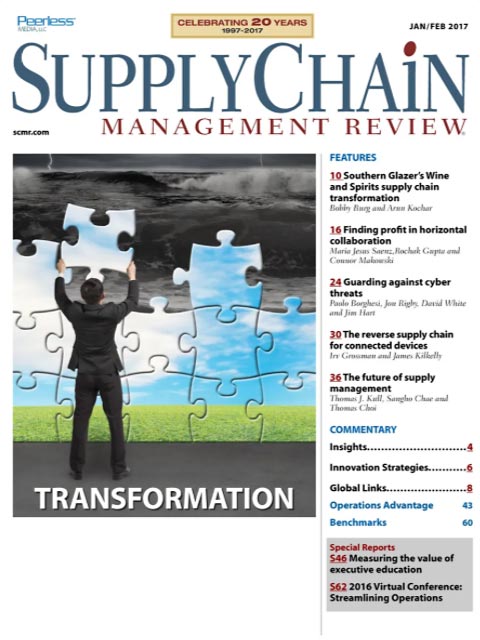Sorry, but your login has failed. Please recheck your login information and resubmit. If your subscription has expired, renew here.
January-February 2017
Transformation is a topic that comes up in almost every conversation I have with supply chain managers these days. Executives from companies as diverse as J&J Vision Care, the division of Johnson & Johnson that manufactures contact lenses, and Thrive Markets, a startup selling health and wellness products to its members, have talked about how they have had to remake their supply chains to meet new customer demands. Transformation is also the theme of this issue of SCMR. Browse this issue archive.Need Help? Contact customer service 847-559-7581 More options
Improving supply chain transparency is a high priority for companies, especially in industries such as foodservice where consumers and regulators are pushing for more publicly available information on how products are made and delivered. Increasing product complexity—the growing demand for organic and gluten-free foods, for example—as well as food safety and security concerns, continues to drive the demand for more transparency.
Responding to these demands is not easy. The fragmented nature of the supply chain can make it difficult to achieve the kind of consensus that is needed to create efficient, end-to-end monitoring systems. However, as the industry responds to the need for more transparency, there is a huge opportunity to take a leadership position. Key to developing the level of transparency that is now expected is changing the behavior of stakeholders and harnessing the power of data visualization technology to present abundant data in easily understood and actionable formats. With these changes in place, the industry can open the way to innovations that could take supply chain performance to a new level. And, the journey provides some valuable lessons for other industries that are striving to meet market demand for increased supply chain transparency.
Data disjoints
The foodservice supply chain is extremely complicated. The companies in this industry sell food that is prepared and served in venues outside the home (the most familiar outlet is restaurants). A complex supply chain that stretches from agricultural growers across the globe to end consumers supports each restaurant. The supply chain also includes manufacturers, freight carriers, forward warehouses, distribution centers (DCs) and third-party logistics providers (3PLs). Many of these players tend to operate in silos that can impede the end-to-end flow of information.

This complete article is available to subscribers only.
Log in now for full access or start your PLUS+ subscription for instant access.
SC
MR
Sorry, but your login has failed. Please recheck your login information and resubmit. If your subscription has expired, renew here.
January-February 2017
Transformation is a topic that comes up in almost every conversation I have with supply chain managers these days. Executives from companies as diverse as J&J Vision Care, the division of Johnson & Johnson… Browse this issue archive. Access your online digital edition. Download a PDF file of the January-February 2017 issue.Improving supply chain transparency is a high priority for companies, especially in industries such as foodservice where consumers and regulators are pushing for more publicly available information on how products are made and delivered. Increasing product complexity—the growing demand for organic and gluten-free foods, for example—as well as food safety and security concerns, continues to drive the demand for more transparency.
Responding to these demands is not easy. The fragmented nature of the supply chain can make it difficult to achieve the kind of consensus that is needed to create efficient, end-to-end monitoring systems. However, as the industry responds to the need for more transparency, there is a huge opportunity to take a leadership position. Key to developing the level of transparency that is now expected is changing the behavior of stakeholders and harnessing the power of data visualization technology to present abundant data in easily understood and actionable formats. With these changes in place, the industry can open the way to innovations that could take supply chain performance to a new level. And, the journey provides some valuable lessons for other industries that are striving to meet market demand for increased supply chain transparency.
Data disjoints
The foodservice supply chain is extremely complicated. The companies in this industry sell food that is prepared and served in venues outside the home (the most familiar outlet is restaurants). A complex supply chain that stretches from agricultural growers across the globe to end consumers supports each restaurant. The supply chain also includes manufacturers, freight carriers, forward warehouses, distribution centers (DCs) and third-party logistics providers (3PLs). Many of these players tend to operate in silos that can impede the end-to-end flow of information.
 SUBSCRIBERS: Click here to download PDF of the full article.
SUBSCRIBERS: Click here to download PDF of the full article.
SC
MR

Latest Supply Chain News
- Analyzing the supply chain risks behind the top data breaches in 2024
- Manufacturing again contracts in October, reports ISM
- 5 common communication issues
- Three frameworks for creative problem-solving in supply chain
- Mitigating geopolitical uncertainty: 4 essential tactics for industrial CSCOs
- More News
Latest Podcast

 Explore
Explore
Latest Supply Chain News
- Analyzing the supply chain risks behind the top data breaches in 2024
- Manufacturing again contracts in October, reports ISM
- 5 common communication issues
- Three frameworks for creative problem-solving in supply chain
- Mitigating geopolitical uncertainty: 4 essential tactics for industrial CSCOs
- Supply chain strategy for medical devices: A Q&A with industry expert Sanjay Gupta
- More latest news
Latest Resources

Subscribe

Supply Chain Management Review delivers the best industry content.

Editors’ Picks





